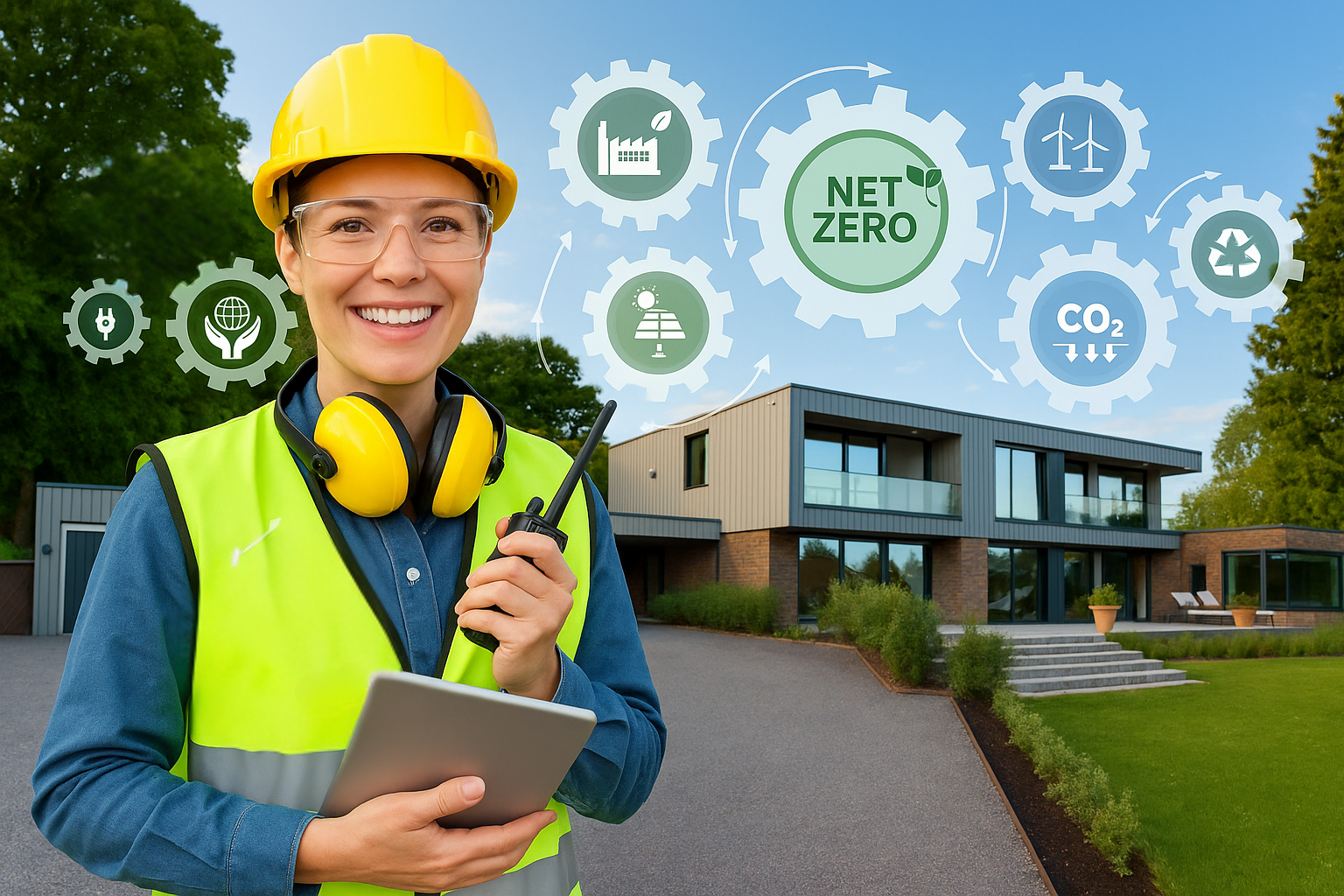Zero Carbon Building Design: What It Means and Why It Matters
The idea behind zero carbon consultancy buildings is easy to understand but challenging to achieve. It means creating buildings that produce no net carbon emissions during their lifetime. That includes everything from the energy used to power lights and heating to the carbon released when materials are made, transported and put together during construction.
In the UK, the push for zero-carbon buildings is growing fast. Government targets now demand sharp reductions in carbon emissions from new developments, making zero carbon part of essential planning from the start. At Ratio Seven, we believe that focusing on both operational energy use and embodied carbon delivers buildings that are smarter and better for the planet.
Building in this way is not just about cutting emissions. It also helps reduce energy costs and improves things like air quality and comfort for the people who live and work in these buildings. It’s the future of construction, and it starts with smart choices at the earliest design stages.
Understanding Operational and Embodied Carbon
To build for zero carbon, we need to look at two key types of emissions: operational and embodied.
Operational carbon is what most people already know about. It’s the carbon released from the energy used to run buildings. That includes heating, lighting, ventilation, and appliances. A good way to cut this is through energy efficiency, using better insulation, windows, and ventilation systems, along with renewable energy sources like solar panels.
Embodied carbon is a bit more hidden. It’s the carbon released when raw materials are made, processed, transported and turned into the parts of a building. For example, making concrete and steel produces a lot of carbon. Low-carbon building design focuses on reducing these hidden emissions by choosing better materials, planning transport routes, and designing buildings that use fewer resources.
We apply both ideas in our work at Ratio Seven, using techniques like SAP calculations to track energy and carbon data. These help developers and self-builders hit their targets for zero carbon.
How Zero Carbon Consultancy Supports Smarter Building
This is where zero carbon consultancy proves essential. Getting advice from expert consultants helps make sure your building reaches low or zero carbon from the very first idea through to completion.
Specialists approach building projects with expert knowledge in materials, engineering, and low-energy use. During the design phase, our consultants at Ratio Seven work alongside clients, architects, and engineers to put achievable carbon-cutting solutions in place early on. We follow the latest building regulations and make sure each stage of the project fits with future-proof standards.
Our zero-carbon consultancy service includes:
- Lifecycle carbon assessments across the whole development
- Detailed carbon footprinting for materials and energy
- Low-carbon material sourcing and advice
- Compliance with UK regulations on emissions and energy performance
- Collaboration with architects and project management teams to meet both design and carbon goals
Consultants also break down complex data to guide real-world decisions. For instance, we can show which material choice cuts more carbon per pound spent, or which energy system will save money in the long run. Our goal is to give practical, clear answers when choices affect the environment and the budget.
Practical Moves in Low-Carbon Building Design
Designing for zero carbon means getting things right from the start. That’s why our consultants begin every project with a solid carbon and energy performance model. Whole life carbon analysis looks at not only the emissions today but across 60 years or more of a building’s life.
We also use the latest modelling tools to understand how a building will perform in real life, before it’s built. That includes checking insulation, indoor air quality, heating demand and day-to-day energy use. For embodied carbon, we measure emissions linked to construction parts like concrete, steel, timber, insulation, and windows.
Good low-carbon building design choices might include:
- Using recycled or locally-sourced materials
- Swapping concrete for low-carbon alternatives
- Designing for natural sunlight to reduce lighting use
- Using timber frames and modular designs to cut site work
- Adding solar roof panels and heat pumps for cleaner energy
Close teamwork is vital. When architects and engineers involve us early, we can help shape the design itself, not just review it after decisions are fixed. Changes made later in the process cost more and do less to cut carbon.
We’ve worked on everything from self-build homes to commercial developments. No matter the size of the project, our advice makes sure zero carbon targets are planned in, not added on.

Benefits of Working with a Zero Carbon Consultancy
The biggest benefit of working with a zero carbon consultancy is getting a building that performs much better in energy terms without adding unnecessary cost or risk. Let’s take a look at what clients usually gain.
First, energy bills drop when buildings use less power. Better insulation, smarter controls, and clean energy systems all add up to long-term savings. Especially with recent increases in energy prices, this makes a real difference.
Second, your building will be ready for the future. Rules about carbon and energy are getting tighter every year. A low-carbon building is less likely to need retrofitting or upgrades later to stay legal.
Third, clients can promote strong sustainability and environmental performance, something many tenants, buyers and investors now look for. This opens up more opportunities for sales or rentals through estate agents.
Fourth, a strong carbon plan gives confidence that the numbers are accurate. Measurement and tracking are clear, and the final report is trusted because it’s checked using recognised methods, including third-party assessments when needed.
And beyond the numbers, buildings created with low carbon in mind are often more comfortable to live or work in. Better ventilation, daylight, and temperature control mean fewer health complaints and less time lost to heating or cooling problems.
How Ratio Seven Helps You Build with Confidence
Whether you are taking on a single house, a full housing development, or upgrading existing buildings, working with Ratio Seven gives you clarity and confidence that your build is headed in the right direction.
Our practical advice covers all stages, from planning through construction. We understand UK building regulations and match your project goals with fine-scale carbon and energy data. We also work alongside contractors, project managers, and developers to help manage risks and make sure work stays on track.
Our experience includes residential, commercial, and mixed-use schemes, and guides smarter decisions on everything from renewable energy to employment practices on site.
Most of all, we help clients avoid costly trouble by answering this simple question: how low can your carbon footprint go without compromising quality, cost or comfort?
Why Early Involvement Makes the Biggest Difference
Any designer or builder will tell you that early decisions shape everything else that comes later. That’s why early advice from zero carbon consultants is powerful.
If a building starts with poor orientation, oversized rooms or unsustainable materials, it becomes much harder to correct that later. By talking to a consultant before the first sketch becomes a full plan, you make sure every step builds towards the right kind of result.
We work best when plans are still flexible. This means we can steer choices toward lower carbon results without getting in the way of what makes the project unique or appealing. Design doesn’t have to suffer just to hit targets.
It also helps when our consultancy is joined up with technical services like SAP assessments and air quality checks. We bring it all together, so your finish is simpler and neater.
Your Route to Zero Carbon Success
The push for zero-carbon buildings is no longer optional. The UK has made clear promises to cut emissions. Builders, businesses and homeowners now play a key role in keeping those targets on track.
At Ratio Seven, we guide every kind of client on this journey. Our zero carbon consultancy and guidance on low-carbon building design means we bring clarity and workable solutions. By making the complex simple and the targets achievable, we help turn ideas into real results.
Whether you’re building a new home, starting a development or upgrading an existing property, we’re here to help you do it the right way, with less carbon and more care.
Plan for Zero Carbon Success With Expert Help From Day One
If you want clear guidance and a smarter way to reach zero-carbon aims, working with a trusted consultancy makes all the difference. Ratio Seven covers every stage of your project, offering reliable input on design, materials, energy, and long-term carbon performance. Make the smart choice.
Talk to us early, and let’s build a future where every project counts.




